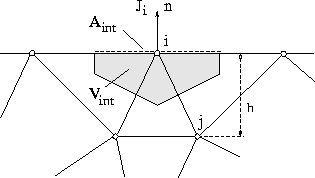



Next: 4.1.3 Nonlinear Equation Solution
Up: 4.1.2 Discretization of the
Previous: Time Discretization
The simulation domain is a finite region determined by boundaries at the
periphery of the simulation domain. For a full description of differential
equations the boundary conditions at this external boundaries are
essential. They affecting the solution variables inside the simulation
domain. Figure 4.1-9 shows a discretization box around the
boundary grid point i. The spatial discretization has already accounted
for the box volume  during discretization of the divergence
operator. The boundary conditions can now be specified via a flux
during discretization of the divergence
operator. The boundary conditions can now be specified via a flux
 across the interface area
across the interface area  in the direction of
in the direction of
 or by simply specifying the value of
or by simply specifying the value of  at the interface grid
point. A general formulation of a boundary condition is given in
(4.1-20).
at the interface grid
point. A general formulation of a boundary condition is given in
(4.1-20).


Figure 4.1-9: Boundary
discretization box for the box integration method. The boundary condition
rely upon the flux  across the interface
area
across the interface
area  , the boundary concentration
, the boundary concentration  or the next inner
concentration
or the next inner
concentration  .
.
It depends on the coefficients  and
and  , which kind of boundary
condition is used. The following boundary conditions can be deduced from
(4.1-20):
, which kind of boundary
condition is used. The following boundary conditions can be deduced from
(4.1-20):
- NEUMANN:
-
 ; specifies the flux across the interface area. If
; specifies the flux across the interface area. If  , we have
homogeneous Neumann boundary condition, which leads to dopant conservation
within the simulation domain.
, we have
homogeneous Neumann boundary condition, which leads to dopant conservation
within the simulation domain.
- DIRICHLET:
-
 ;
specifies a specific value to be fixed for the solution on the boundary
point. These Dirichlet points represent the exact solutions at these
boundary points. Hence, they are eliminated from the system matrix prior to
solving the linear system.
;
specifies a specific value to be fixed for the solution on the boundary
point. These Dirichlet points represent the exact solutions at these
boundary points. Hence, they are eliminated from the system matrix prior to
solving the linear system.
- CAUCHY:
-
 ; mixed boundary condition comprising particle flux and
concentration value at the boundary. This is often used to specify particle
transport over the boundary, i.e. interface kinetic, oxidizing surface
conditions.
; mixed boundary condition comprising particle flux and
concentration value at the boundary. This is often used to specify particle
transport over the boundary, i.e. interface kinetic, oxidizing surface
conditions.
- SECOND ORDER:
-
 ; boundary points as well as inner points are used to
specify the dopant flux across the interface. Generally, homogeneous Neumann
boundary conditions are assumed for the artificial boundaries of the
simulation domain to ensure dopant conservation. The simulation domain must
be selected large enough that this Neumann boundary conditions have no
impact on the solution. If point defects are involved in the diffusion
process the simulation domain has to be extended to several hundred microns
due to the high diffusivity of the point defects. To avoid these large
simulation domains a second order boundary condition can be used to
approximate the dopant concentrations at the interface by expression
(4.1-21), where k denotes a prefactor (mostly depending on the
diffusivity D),
; boundary points as well as inner points are used to
specify the dopant flux across the interface. Generally, homogeneous Neumann
boundary conditions are assumed for the artificial boundaries of the
simulation domain to ensure dopant conservation. The simulation domain must
be selected large enough that this Neumann boundary conditions have no
impact on the solution. If point defects are involved in the diffusion
process the simulation domain has to be extended to several hundred microns
due to the high diffusivity of the point defects. To avoid these large
simulation domains a second order boundary condition can be used to
approximate the dopant concentrations at the interface by expression
(4.1-21), where k denotes a prefactor (mostly depending on the
diffusivity D),  the equilibrium dopant concentration and h the
perpendicular distance to the interface.
the equilibrium dopant concentration and h the
perpendicular distance to the interface.





Next: 4.1.3 Nonlinear Equation Solution
Up: 4.1.2 Discretization of the
Previous: Time Discretization
IUE WWW server
Wed Jul 10 16:10:00 MET DST 1996

![]() across the interface
area
across the interface
area ![]() , the boundary concentration
, the boundary concentration ![]() or the next inner
concentration
or the next inner
concentration ![]() .
.![]() and
and ![]() , which kind of boundary
condition is used. The following boundary conditions can be deduced from
(4.1-20):
, which kind of boundary
condition is used. The following boundary conditions can be deduced from
(4.1-20):